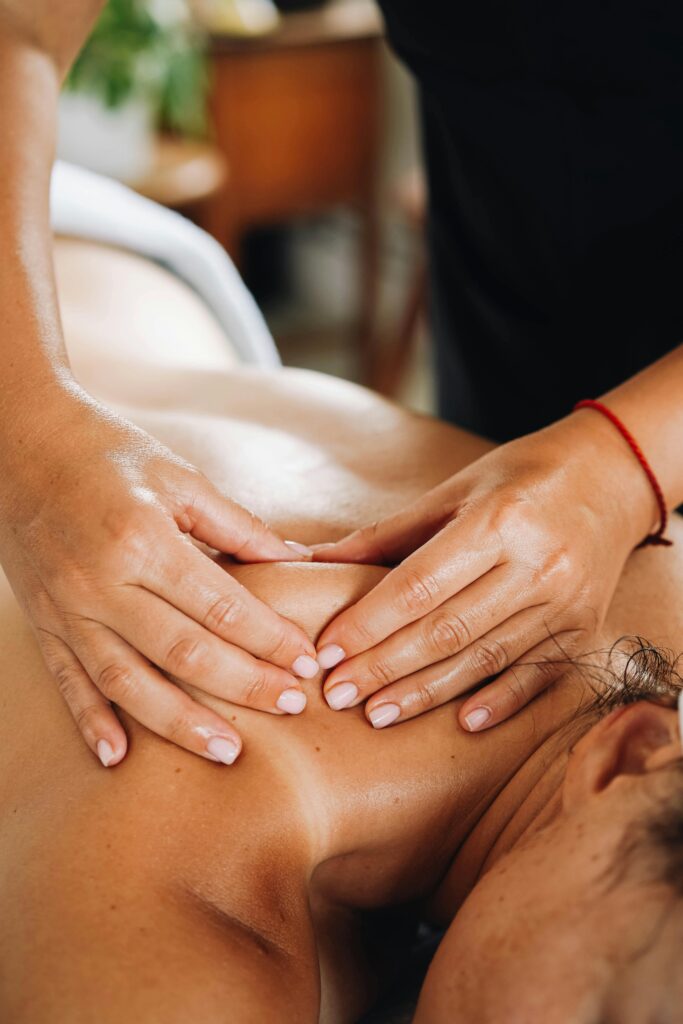Struggling with
Shoulders and neck
Improve range of movement, remove knots and relieve strains in the shoulders and neck
Day to day activities
Everyday life plays in impact on shoulder pain, whether that’s picking up your kids or washing your windows.
Swimming
Swimming is intensive on the shoulders due to repetitive overhead movements often causing strain around the rotator cuff muscles
Poor posture
Slumped sitting in daily life eg. when driving driving or desk work, can cause tension around the neck and upper shoulder
Stress
When stressed the body can respond by tightening muscles, this is often around the shoulders and neck
Did you know?
27kg strain
Your head weighs as much as a bowling ball and your neck holds it up all day.
That’s around 5–6kg balanced on a relatively small structure. Poor posture (like forward head position at a desk) can increase the strain on your neck muscles up to 27kg – no wonder it gets sore!
Shoulder stability
The shoulder is the most mobile and most unstable joint in the body.
It can move in nearly every direction, but that freedom comes at a cost: it relies heavily on muscles like the rotator cuff for support. Weakness or imbalance here is a major cause of pain and injury.
Nerve pain
Tension in your neck and shoulders can cause tingling in your hands.
That’s because nerves like the brachial plexus travel from your neck down to your arms. If tight muscles press on them, it can create numbness, pins and needles, or weakness in your hands.
The Shoulder in Motion
The shoulder is a ball-and-socket joint formed by the humerus, scapula, and clavicle. Major shoulder muscles include the trapezius, rhomboids, deltoid, and rotator cuff muscles, responsible for moving the arm in different directions and keeping the joint stable. Neck muscles include the sternocleidomastoid, trapezius, and scalenes, which are responsible for head and neck movements
The Nerve Highway
The neck (cervical spine) contains seven vertebrae and houses nerves that travel from your brain down into your shoulders, arms, and hands. Key nerves like the brachial plexus branch out from the lower neck and upper spine to control movement and sensation throughout the upper body.
When muscles in the neck and upper back are tight, or posture is poor, it can lead to nerve compression or irritation. This can cause; tension headaches, pins and needles down the arm.


Typical Treatment
A typical treatment cycle is between 3-6 weeks with 45 minute massages focused on relieving tension across targeted muscle groups.
As shoulder pain can be caused by multiple muscle groups, the initial consultation will begin with a functional assessment to identify key areas of focus.
Possible areas of focus:
Trapezius: Muscle at the base of the neck across the shoulders and down to the middle of the back
Scalenes: Group of muscles on the side of the neck
Deltoids: Long muscle that covers the shoulder joint
Rhomboids: Muscle on the upper back, between the shoulder blades and the spine
Rotator Cuff: A group of muscles and tendons that surround the shoulder
Sports massage techniques are used to warm up the area, assessing common trigger points in the traps and muscles surrounding the scapular. Active and passive mobilisations used to increase range of movement.
Have more questions? Why not have a read of our FAQ.
Get in touch
Prime Fitness 247
31-33 Market Pl, Knaresborough HG5 8AL
Tel: 07592224592
Email: contact@dailysummits.com
Opening Hours
Appointments are limited and tailored to your needs. Reserve and experience the difference of focused one to one care.
Mon - Fri
09:00 - 19:00
Sat
11:00 - 16:00
What Our Customers Say About Us


